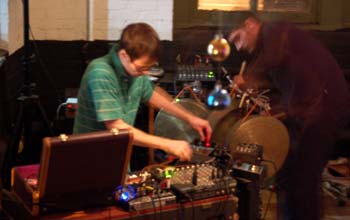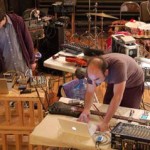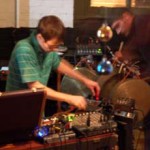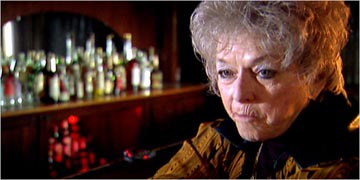Sound art, like any newer medium that has been around for about a century, has had to re-work our definitions of what art, and more specifically in this case music, can be. After attending the Local Experimental Music Showcase presented by Non-Event on December 9th, I tossed around a few notions of where sound art fits in generally. Boston has an extremely receptive audience to experimental sound/music, and like most other studies of art it seems like it’s taken quite some time—sometimes an unbelievable amount of time—to break through to a great reception.
Non-Event is trying to break through and expose some of the goods inside to this extremely receptive audience and hopefully a few more here in Boston. Hosted by sQuareone productions, the line up for the Local Experimental Music Showcase included four variously intense sets, one each from: Red Horse, Marc McNulty, Ernst Karel, and the duo of Derek Hoffend and Jonathan Chen. Sound and its amazing capacity to render you susceptible to emotional, intellectual and, of course, physical reactions, was doing just that this particular evening.
Derek Hoffend and Jonathan Chen started out the night with a modified bass guitar lying on a table with tiny motors attached to the strings. Hoffend hovered over it while he plugged away at pans and fades of his field recordings of crackling, baking food and steam radiators. He kept the dialogue between he and partner Jonathan Chen via his eyes and stopwatch, bringing us into various smooth decisions they each made as the vibe pulsed. Chen seamlessly used SuperCollider, (software that manipulates sound with a synth/algorithmic composing system) to layer clips against the womp of bass and bits. The piece gained a great momentum just before a curious thing happened: Chen picked up a violin.
Having done a little digging, I found that Chen is a bit of a virtuoso on the violin, though he was dismissive about discussing his training with the instrument. He was also not interested in not being interested in it, just the same (pretty much exactly his words). When he picked up the violin, things suddenly turned more performative for the duo. Although he did not actually “play” the violin, it was pretty sensational the way he interacted with the instrument. Barely tapping out notes, the restraint created for the end of the performance was perfectly lucent with some kind of fervent delicacy.
Ernst Karel had the most allusive performance of the evening, with his overall directness and isolating sounds presenting a striking disconnect to the other three, more ‘musical’ performances. This piece, where in my notebook my scribbled notes to ask what the difference might be between noise and sound-scape, was the most difficult for me to process live. I found myself picking out sounds rather than knowing those sounds are all making one, collaborative piece. In retrospect, I think of this piece most often when I think of this show; intellectually I can’t help but think of Karel’s set in reference to someone like Cage. The isolations in his sound-scape create something new — an awareness and focus that allow what our preconceived notions of noises he employs (bells, etc) to be unraveled and escape the familiarity of how we typically categorize them.
I took a break while I sat with my back to the wall during Marc McNulty’s ‘acousmatique’ piece. This, a definitive and solid musical composition from McNulty (though he also assembled its parts live) was constantly inviting with different grooves made from his field recordings. He immersed us in a stack of layering from various clips he arranged in the program Ableton. His performance provoked me to draw, rather than jot any notes into my notebook, as it had a fluctuating rhythm of motion that was really on, and didn’t make me think too much. This takes a certain skill; to compose well enough that complexities don’t go unnoticed and yet have ephemeral effects you slip into from time to time. McNulty gave a fantastic performance, including a curiosity toward the end of the piece where music seemed to turn into the reality of men talking on walkie-talkies.
The last performance of the evening rocked the house—there is no other way to say it. To describe the flavor of intensity would have to do with dizzying audible hurricanes made from the incredible forces of sound and energy. What Steve Pyne, working with organ feedback, and Eli Keszler who performed on drums and percussion, were able to unleash was extraordinary. Pyne played the organ through some homemade electronics and rerouted it all back into the organ, creating loops of feedback. He also used a Leslie Cabinet, which is essentially a speaker with a rotating cylinder that creates a pulse, to which Keszler seemed to try to mimic with an assortment of hanging gongs. I’m exhausted thinking about all of what it takes to put some of these performances together technically.
Based on the dynamics of the bunch, the performers who worked in tandem, and what raw energy they can each try to harness and float upon for a stretch, it served for one hell of an energized show, Non-Event has established itself as where it’s going within the experimental scene. You’ll surely be in for a satiated belly full of something freshly experimental, independent and a clutch on the pulse of what’s happening on the periphery.
Links:
Non-Event
An Mp3 podcast featuring music by each artist from the showcase.
All images are courtesy of the artist and Non-Event.






